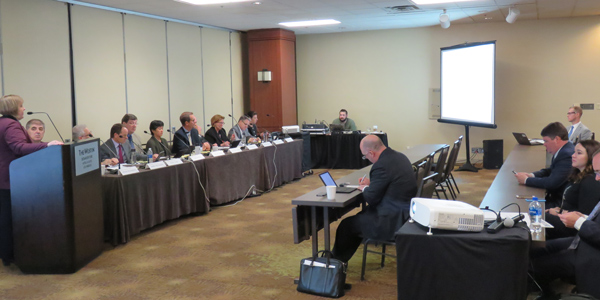By Jason Fordney
LOS ANGELES — Western Energy Imbalance Market (EIM) leaders last week endorsed CAISO’s controversial proposal to give generators more bidding flexibility, but not without giving ground to the plan’s skeptics.
The EIM’s Governing Body on Thursday approved the ISO’s Commitment Costs and Default Energy Bid Enhancements (CCDEBE), designed to give generators more latitude in how they reflect their commitment — or start-up and minimum load — costs and overhaul the way the ISO calculates the default energy bid, which replaces bids of units found to have market power.
The current method can artificially limit a generator’s commitment cost and limits what the generator can bid in, the ISO has said.
But to the end, market participants and the ISO’s Department of Market Monitoring raised questions after a lengthy stakeholder process to develop the rules. (See CAISO Developing New Bidding Rules.)
The rule changes still require approval by the CAISO Board of Governors, which will consider the proposal at its March 21-22 meeting.
‘A Good Place’
CAISO’s proposal replaces a static commitment cost bid cap with a local market power mitigation test, which identifies whether a resource needs to be committed to relieve a transmission overload or other constraints, the same way energy bids are handled. The ISO will only mitigate bids when a generator fails the test.
Under the current rules, the ISO calculates reference levels for each gas-fired generator based on published natural gas price indices. The commitment cost reference level is determined by multiplying costs by 125% and bids are capped at the generator’s reference level.
CAISO plans to phase in commitment cost bidding flexibility, first raising the commitment cost multiplier to 150% for the first 18 months after implementation, and then increasing it to 300% if no issues arise.
During the rulemaking process and at Thursday’s meeting, there was heavy debate over CAISO’s plan to automatically increase the reference levels after 18 months. Some commenters, such as Governing Body member Kristine Schmidt, suggested that a new stakeholder process might be needed at the 18-month point.
But CAISO Vice President of Market and Infrastructure Development Keith Casey resisted the idea, saying “it sends a message to the market that we are not serious about this.”
Body members compromised by adding a provision to the decision that the ISO provide a status report to the EIM and CAISO board at the 18-month point.
“This was tough one, but I think we ended up in a good place on this,” Governing Body Chairman Douglas Howe said.
The ISO recently lowered the proposed multiplier for the first 18 months to 150% from 200%, in an “abundance of caution,” Market Design Manager Brad Cooper said, calling the bid cap a “circuit breaker.” The proposal also allows suppliers to seek adjustments to their reference levels based on changes in documented costs.
“We believe that we have a robust design, but we agree we need to proceed cautiously with changes,” Cooper said during a presentation to the Governing Body.
Respectful Disagreement
DMM Director Eric Hildebrandt supported the proposal, saying “the basic framework is there.” But he recommended a few changes, saying there are some gaps, a potential for economic withholding and for a “kind of gaming.” (See Monitor Critical of CAISO Commitment Cost Mitigation Plan.)
“We have looked at it, and we respectfully disagree,” Casey responded, adding that some power suppliers are “sort of biting their tongue” on the arrangement for the first 18 months. An automatic change at the 18-month point provides certainty that the ISO is committed to moving to the higher cap, he said, adding that CAISO can always file with FERC to keep the level at 150% if it discovers issues.
Howe said the EIM’s decision “is trying to carve a middle road,” but he didn’t think CAISO should “back into” a second stakeholder process that would “allow everybody to have a second bite” at things they didn’t like.
Body member John Prescott said, “I support this, and I would advise the Board of Governors to support this as well.” He said he expects the DMM to make sure issues don’t materialize.
Representing the Western Power Trading Forum, Carrie Bentley of Resoro Consulting told RTO Insider that the parties most affected by the change will be EIM entities or others who have experienced challenges with CAISO calculating their proxy costs, and generators and scheduling coordinators impacted by high gas prices.
She said that while WPTF supports the proposal, she called CAISO’s changing the reference level late in the proceeding “an unfortunate circumstance of panic policymaking in response to a few influential stakeholders. The CAISO had an excellent proposal, and it would have been better if they just remained confident in it.”









